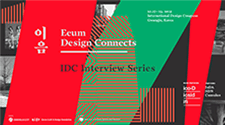Eeum Design Connects interviews Neville Brody

20.01.2015 Features
Neville Brody, Dean of School of Communications, is one of the featured speakers for the 2015 IDC Eeum Design Connects event in Gwangju Korea. The following is a special interview conducted by Don Ryun Chang, Organizing Chair of the event during his recent visit to Seoul.
Don: What are your expectations for the event? What are the topics that you are considering to talk about during our 2015 event?
"How strong should you be as an individual practitioner? Or should you be able to be also the person who sits at the front of the supermarket and sells everything, responsible for the design of the store, packaging, content, service, communication, sound, movement, and security systems? Design is becoming everything, or everything is designed."
Don: For designers who are considering all the elements of change, such as technology, social media, changing sensibilities, how can they realize their role in the society? With the projects they are currently doing, what are some of the issues that they need to realize in order to function?
Neville: Graphic designer as we know it, or knew it, is no longer relevant. In the old days a company will come to you and say the logo is not working so make me a new one. This is no longer relevant to what works in the modern world.
Graphic design is much more about narratives, storytelling, a series of episodes and the language you use to tell those stories. In a way a designer becomes more of an orchestra conductor. As everything is going on at the same time, you just have to be there making sure that it’s flowing in the right direction and doesn’t sound too discordant.
It’s a job without end. You don’t just give a logo and that’s the end of the story. Actually the logo is one tiny part and most people don’t even recognize that the logo has changed. In social media especially, it’s just about how you tell the story and what the story is. What does it involve? Maybe that moves into other areas as a set like sound, spatial design or even strategy for content. So the role of the designer is vastly different, but we can use some of the skills we learned in graphic design to apply to this.
Don: As an educator as well as a professional with extensive experience, how do you prepare and train your students into this new reality?
Neville: It’s a serious challenge and I think every design and art school in the world will be going through this problem. How do you teach specialism in a non-specialist environment? The way we try and think about it is that you still need some subject depths because there still needs to be a sense of discrete profession. In Japan, everything is looked at holistically--all the pieces fit together in a component way. Those components still need to be defined. If you don’t have defined components you can’t have molecular structure. I think it’s a mistake to throw everything out, but it’s also a mistake to be too specific. How do you find the middle way?
"We are taking an approach that we call 'low walled gardens.' Each garden can be fairly specific, but the wall is low and people can walk from garden to garden. These aren’t secret gardens. Instead of having disciplines we have themes. A theme might be expressions, articulation, spatial design, or temporal, which means time-versed. In each of these themes you can find multiple groups of crafts that are necessary."
Don: So what would your recommendations be for examples educators, university professors with design programs? How can they sort of re-evaluate their current curriculum to reflect this kind of phenomena?
Neville: We have become brokers that negotiate between different states and spaces, past and future, different skill sets, as well as different expectations. A student coming in might come in as an illustrator, but we need to negotiate between his/her expectation and the expectation of the modern world, which is that illustration fits as part of lot of other different things. We also have to negotiate between staff who want the old way and staff who feel much more transversal.
"So our role as educators is to become catalysts, not dictators. It’s not about giving a set of embodied knowledge we have. We have to facilitate students in a self-learning environment."
Don: You traveled to many different countries and also had exchanges with many different designers. I think something that young students or professionals are struggling with is finding their cultural identity in the context of design. How can they identify their sense of being with their cultural identity?
Neville: Well the problem is that as we realize corporations are bigger than countries. Global corporations and the new sovereign states are the sovereign states of Starbucks or Amazon: these are the new sovereign states…and we pay taxes to them and then they go and spend them somewhere else. So the world has shifted and we talk about the second law of thermodynamics, which is that heat dissipates. Well heat dissipates and if you apply that to a cultural context and the entropy of culture is that complexity becomes generic. So the local complex model is overtaken by a simplistic DNA. So you have something like local culture, say in coffee drinking or in social activity and then you have a Starbucks that comes in and replaces it with a little bit of local variation. I mean 1% nothing, nothing more. Somehow the local complexity then becomes this global blandness. This is happening. So, how do you find your personal local cultural identity within that? Well that’s not possible. The only way you can do it is to step out of the grid or to become a new multinational.
Don: That’s rather bleak!
Neville: It’s bleak, but I think what’s starting to happen in the UK and the US will happen elsewhere. Supermarkets are now losing ground and there’s some realization that actually locality is more important. Some boutique agencies and shops as well as local cafes and restaurants are now surging in popularity. I see even in Korea there are a lot of small design agencies now springing up of individual positions, which is a very exciting evolution. So I’m very optimistic. And this big monolithic IBM companies inevitably get broken up at some point. So we hope for the empires to collapse.
Don: My final question is on sustainability. How can the design profession or for designers be sustainable?
Neville: Well it’s a contradiction, isn’t it? Because what we do as designers contributes to global warming. In fact, if we are true to sustainability, we would stop producing anything. As soon as we do a package design, introduce a brand, put a newspaper out or even design a website, we are actually using up global resources. So the real thing to do is just to do nothing. If we are going to communicate to try to get the message through, we should try to do it in the most sustainable way possible. These are big challenges. People are flying in from all over the world for a conference. What will be the carbon footprint of the conference? We can do something in the conference deliberately that offsets the global footprint.
Don: Thank you Neville!
For more more information and regular event updates:
Visit the and the Congress website:
2015idc.org
* The views and opinions expressed herein are those of the author and do not necessarily reflect those of ico-D.

relatedarticles

goodbye! and next steps for colleague and friend alexey lazarev

explorations in ethical design: meditations on equality

RCA launches new programme: MA Digital Direction

Interview | Ermolaev Bureau (Moscow)
